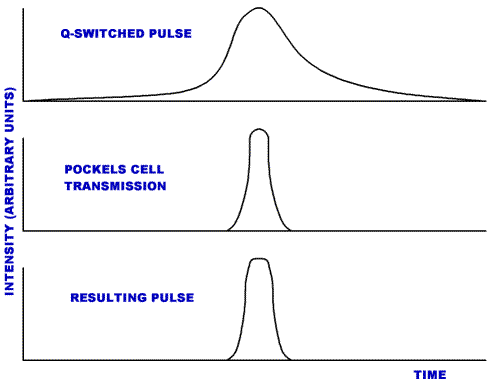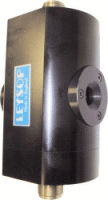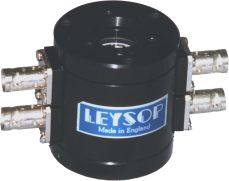It is well known that the generation of short duration, intense optical pulses may be achieved by the technique of laser Q-switching. The laser’s circulating stored energy field is kept from building up to any appreciable output level by introduction of an intra-cavity loss mechanism which lowers the round trip gain below unity and laser output is suppressed. If the laser medium is continually pumped with energy during this process, the absorbed pump energy is stored in the excited atomic field until a significant population inversion is obtained. The loss mechanism is then rapidly removed and the cavity gain increases to a high state. A pulse of energy soon builds up from the optical noise and all the stored energy is (hopefully) released as one giant “Q-switched” pulse.
What then you ask is the problem? Well, the characteristics of the pulse produced by this process are determined by a number of interrelated factors, including the cavity round trip time and gain. In practice, it may not be possible to achieve the desired combination of factors in a practical laser. For example, say that one desires a pulse of duration ~1ns. One Q-switching technology often used is acousto-optic (Bragg cell) based. However, the relatively slow Q-switching obtainable and the high insertion loss prevent the very rapid build up of the pulse required and AO Q-switched lasers typically generate pulses of durations of 10’s of ns. Apart from the rather unique products offered by Advanced Optical Technology Ltd. the much faster electro-optically Q-switched lasers do not usually operate at prf’s above a few kHz. Even then, with the noted exception of the offerings from AOT the pulses are usually of 3 to 5ns duration. What then can one do to obtain this elusive short pulse capability in the context of an existing laser system?
The answer is to use an external Pockels cell to slice the section of the pulse containing the peak of the envelope from the optical pulse, leaving the longer build up and decay portions behind. This way, most of the peak intensity of the pulse is retained and the final pulse duration is shortened.

It all sounds simple, but of course there’s a catch (you knew there would be)! The Pockels cell needed for this operation is not the usual run of the mill type used for Q-switching, but has to be rather special. It must be remembered that as pulses enter the sub-ns regime, the effective electrical bandwidth over which the Pockels cell must operate rises above 1GHz. Special constructions of devices are needed to avoid difficulties when driving with short electrical pulses.
One such device is the Ultra Fast Pockels cell or UPC. This device has been especially designed to offer the cleanest electrical interface to the pulse generating circuit to reduce distortions of the driving signal. The moderate 6mm aperture size is practical for most applications and yet offers rise-times of around 150ps when driven with an appropriate signal. This device is thus ideally suited to pulse slicing applications, particularly when driven by an ultra-fast source such as a high pressure spark gap. Such sources are however very highly specialized and do not provide flexibility in pulse length selection. In applications such as pulse picking where an individual pulse is selected from a pulse train (often to reduce the effective pulse rate of a model locked laser source running at typically 80MHz prf) the rise-time itself is not so important because the optical pulse is already extremely short (ps or even fs). What is important is that the pulse is selected cleanly from the pulse train so the switch on and off times must be fast (~ns) and symmetrical. This is difficult to achieve using conventional pulse driver technology. Switching a voltage to ground is much easier to achieve in the required time, but the return to the high voltage state is usually much slower as the circuit capacitance charging conditions are different to the discharging conditions. What is needed therefore is a device which can produce an effect similar to a pulsed operation device, but when driven from a step function generator.

Pulse Picking With Four Terminal Pockels Cells
One excellent approach to generating a finite duration optical gate from a much longer input step function is to use a pair of Pockels optically in series and driven from the same high voltage edge. The first Pockels cell opens to allow transmission of the beam when the leading edge of the driver pulse arrives. The electrical pulse is then passed to the second cell after an appropriate delay (i.e. a length of coaxial cable) and the second cell opens up but with the optical phase rotation in the opposite direction to that of the first cell. This produces the effect of concluding the transmission of the composite pair of cells until the voltage pulse clears the first cell. Once this happens, the transmission is returned to the high state until the voltage pulse also clears the second cell, that is after the duration of the cable delay. By appropriate choice of pulse length, this second opening of the switch can be timed to occur between pulses and so has little effect on the system performance. The advantage of this approach is that both the leading and falling edges of the gate are determined by the leading edge of the voltage step or pulse. A long recovery of the voltage does not therefore affect the fall time achievable.
There are some difficulties however associated with using two Pockels cells like so. The first is the extra alignment required for two Pockels cells instead of one. Also, the optical transmission will be reduced as there are more optical surfaces involved. This also can lead to more spurious reflections to deal with. Finally, and most significantly, the matching of the two cells has to be very close if good extinction is to be maintained. The variations in deuteration from crystal to crystal in KD*P can be sufficient to upset this balance. The solution to all these problems is a four terminal Pockels cell.
By including a second terminal on each electrode of the Pockels cell, the electrical step voltage which turns on the Pockels cell transmission may be configured to switch off the transmission after a delay determined by a length of coaxial cable connecting the two ends of the cell. The cell is connected at the opposite end to the driver to a 50Ω load via a suitable series capacitance. This has the benefit that under static conditions the Pockels cell sees no voltage across its terminals which helps it maintain a long lifetime. When the voltage step is applied to the first terminal, the voltage appears across the cell as the opposite end is held at Earth potential. The through connection is delayed by the coaxial cable for some moderate period of time (usually up to around 10ns) and then is fed to one of the rear terminals whereupon the overall field across the device is returned to zero. The device is then closed. The voltage step is then finally passed through via the remaining terminal to the 50W load where it is cleanly terminated to minimize reflections. For optimum performance, the voltage step source should also be 50Ω impedance, but this reduces the maximum effective drive voltage of the supply by a half.

